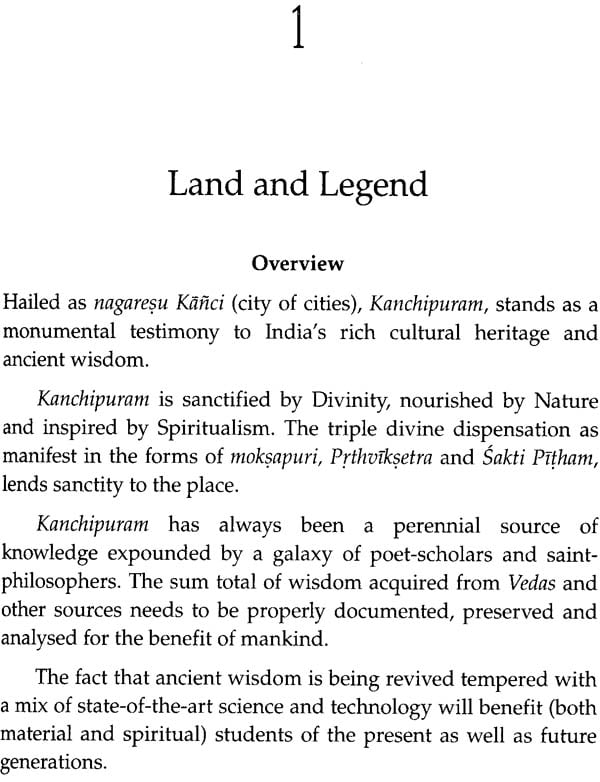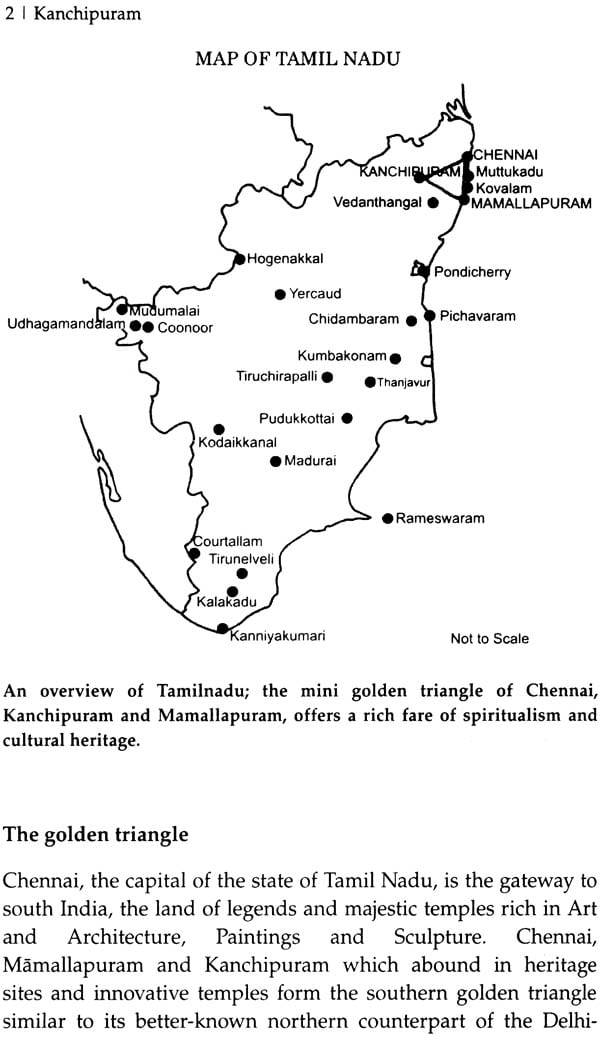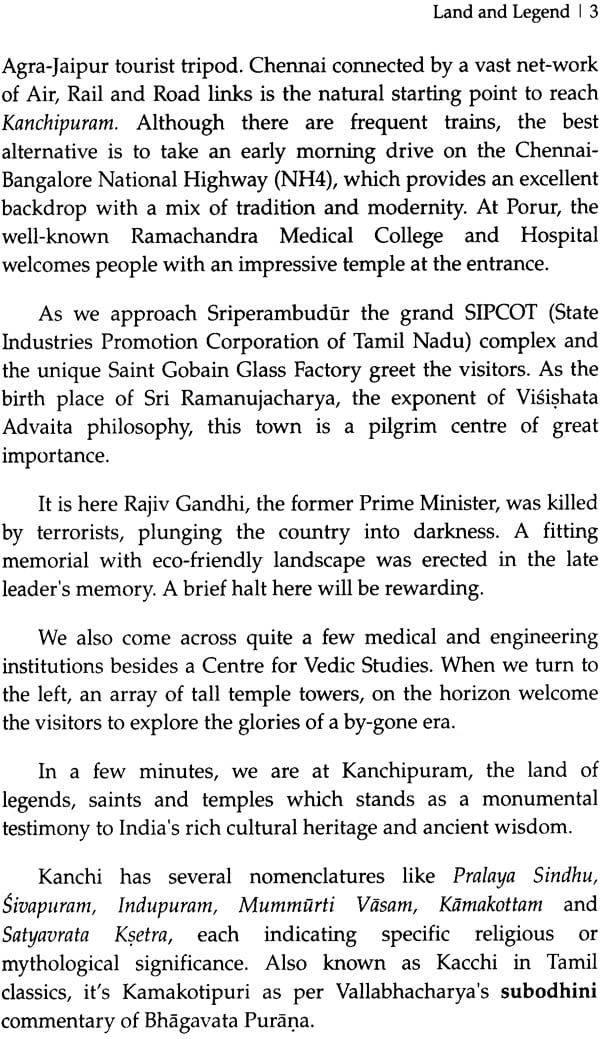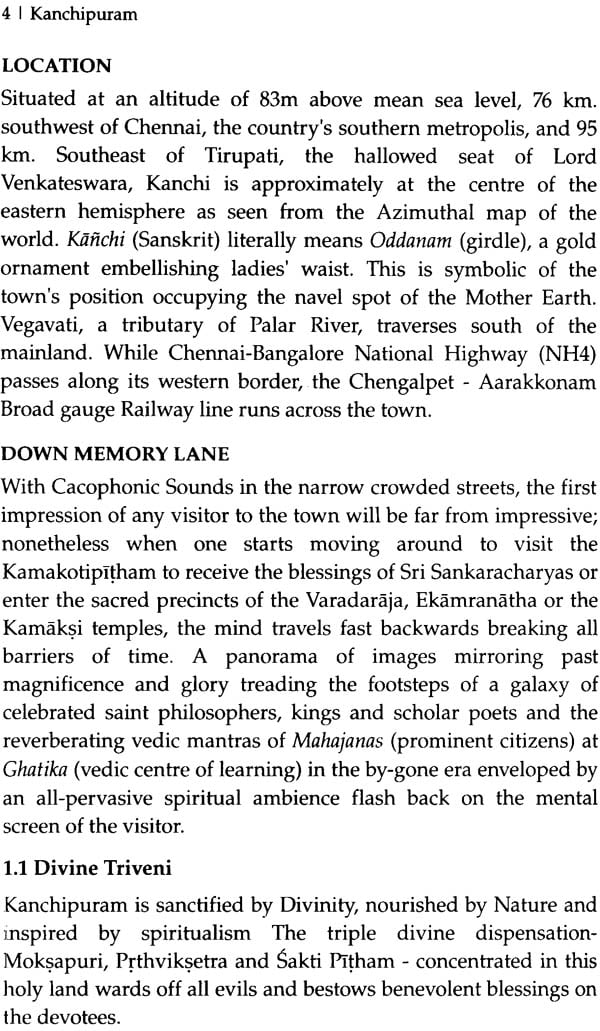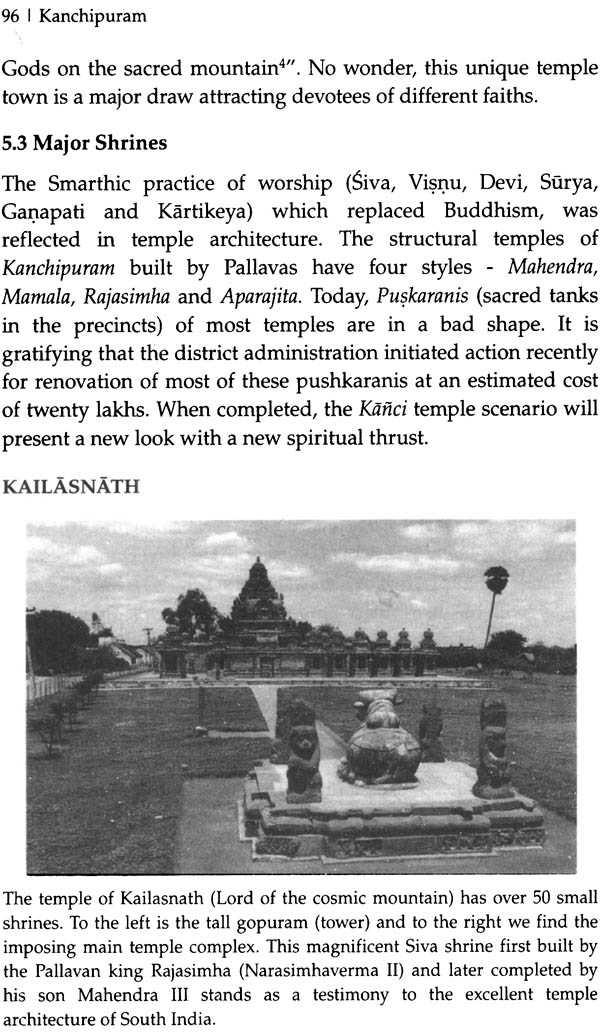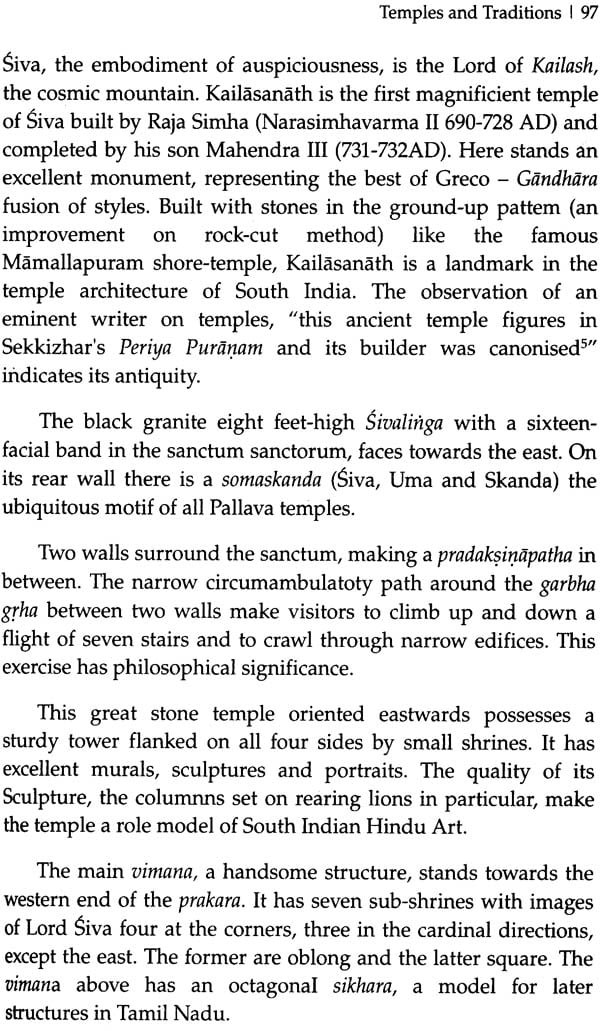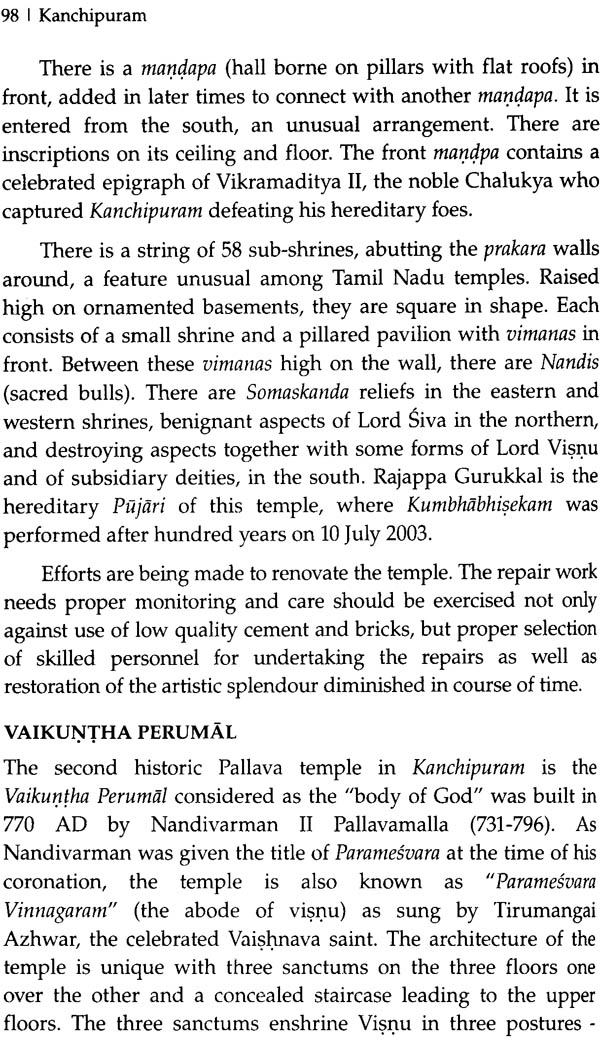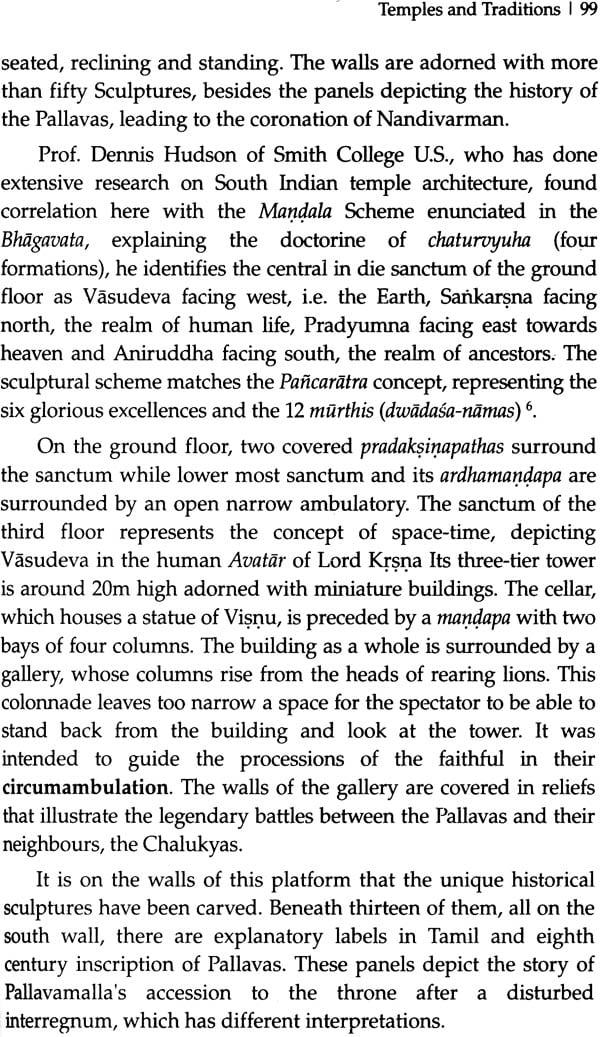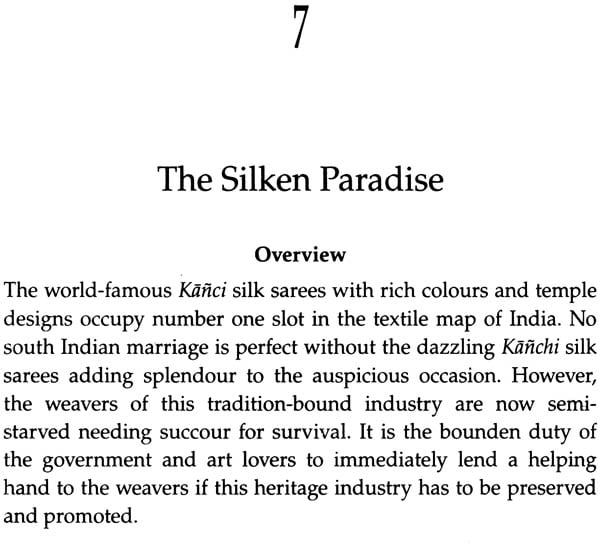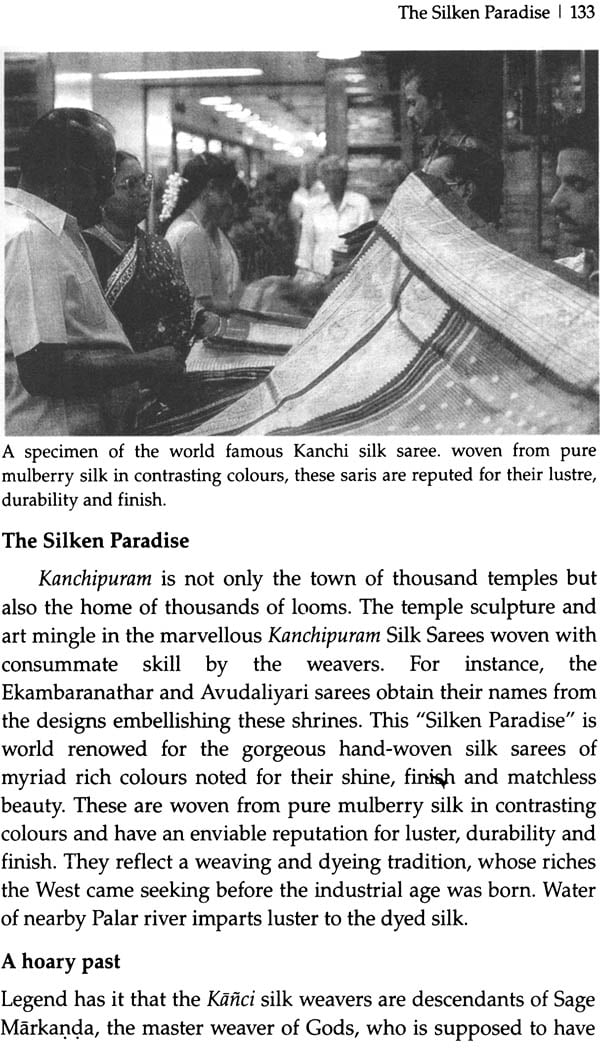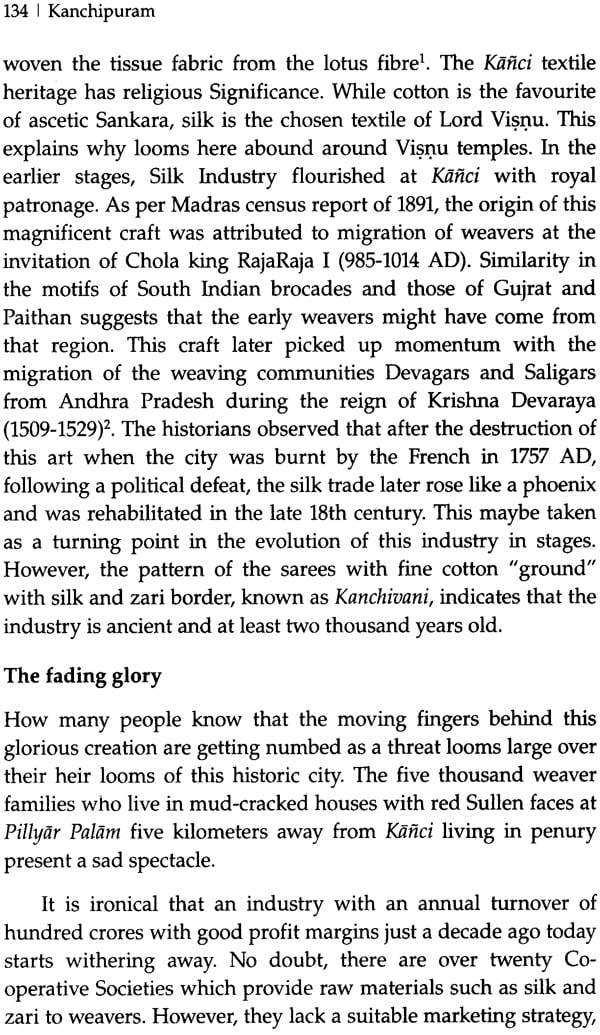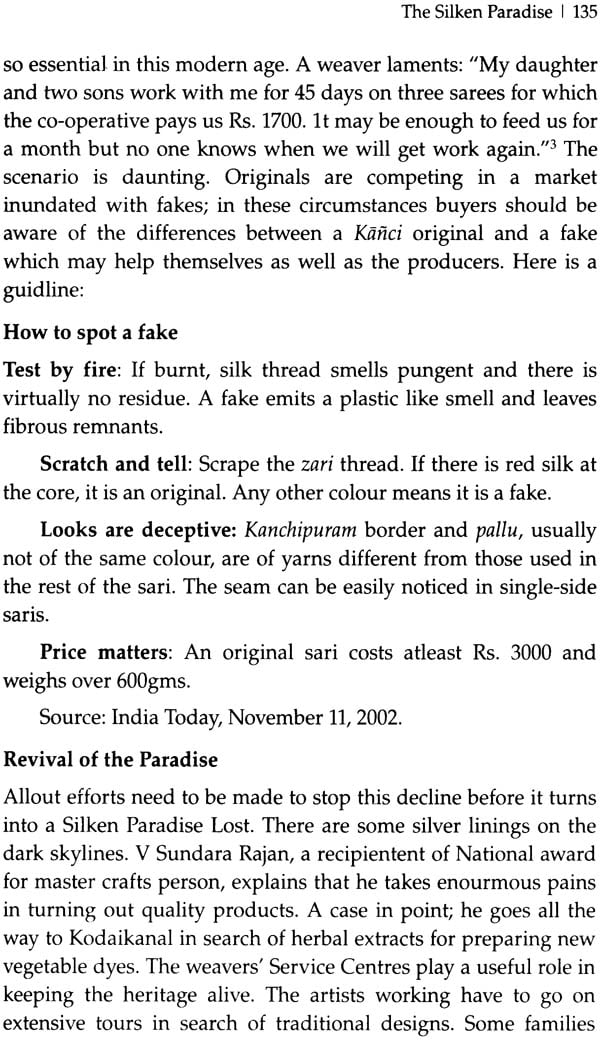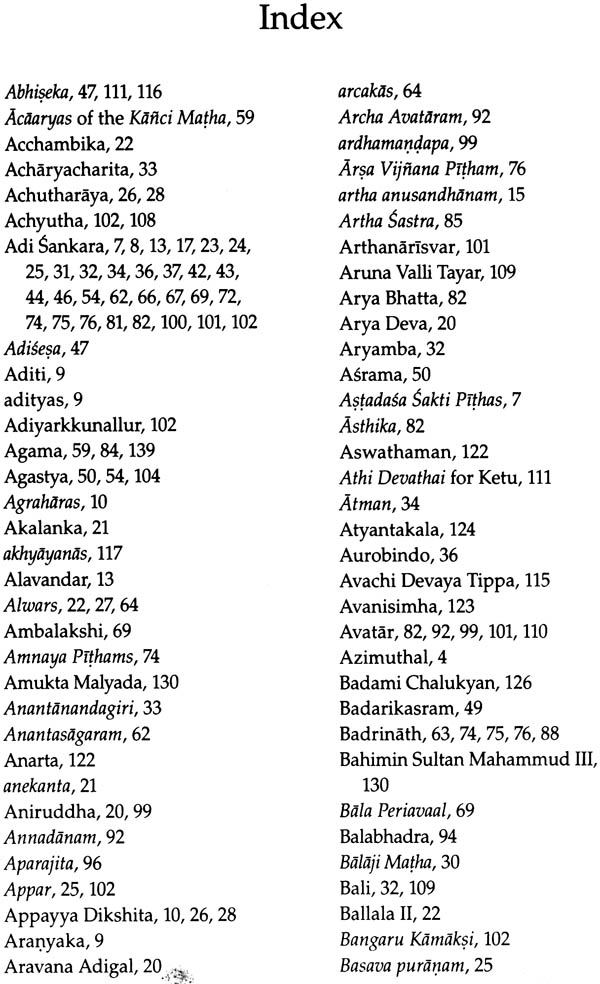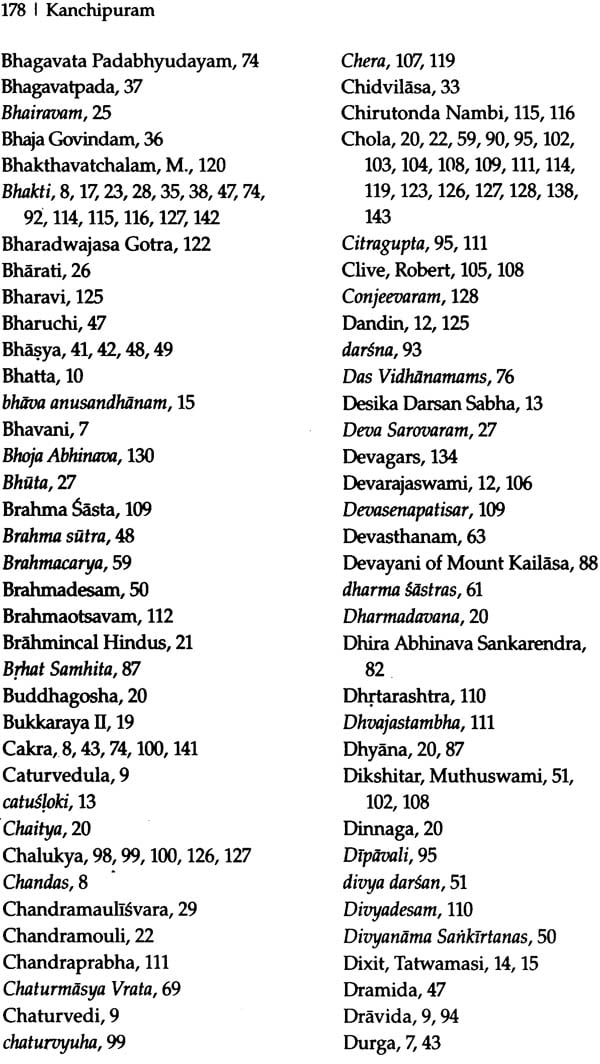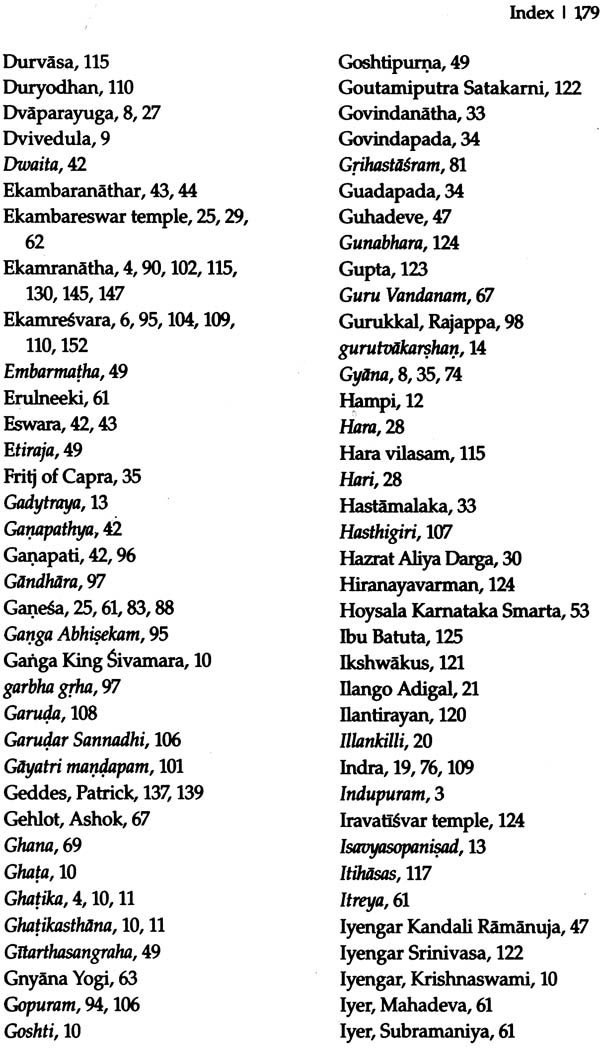
Kanchipuram Land of Legends, Saints and Temples
Book Specification
| Item Code: | IHD002 |
| Author: | Dr. P.V.L. Narasimha Rao |
| Publisher: | Readworthy Publications Pvt. Ltd. |
| Language: | English |
| Edition: | 2008 |
| ISBN: | 9788189973544 |
| Pages: | 216 (1 Color, 10 B/W Illustrations) |
| Cover: | Paperback |
| Other Details | 8.5" X 5.5" |
| Weight | 350 gm |
Book Description
Prelude
With comprehensive information on temples, saints and dynasties that ruled with Kanchipuram as the capital, this book will be of interest to general readers, tourists and pilgrims. At the same time, an overview of India’s cultural heritage is presented as a backdrop for enabling the reader to appreciate the pivotal role played by Kanchipuram in the genesis and evolution of the spiritual movement in India.
Why this book?
People ask the relevance of a heritage book in this age of computers.
Eminent personalities both in India and abroad have answered this question long back. For instance, Professor E.D. Hirch of Virginia University who authored the bestseller, Cultural literacy (what every American should know) stated in 1987: “The more computers we have, the more we need shared fairy tales – mythology, historical images and so on”. U.R. Anantamurthy in his speech during the Annual Writers’ conference in Colombo on September 30th, 2002 observed: “All our memories of our past in our countries are preserved in our folk tales, songs, performances and myths. As writers we owe an obligation to our past as well as to the present to continue what is best in our literary traditions, not by imitating the past but creatively interacting with it.”
Quite a few medieval saint-poets like Basava, Tukaram and Kabir besides Adi Sankara, the universal teacher, had been critical insiders themselves. They tried to restore rational norms in religion by demolishing an array of whimsical and repulsive practices prevailing in those time. For instance, Adi Sankara reduced over seventy religious streams into just six main branches highlighting the core values of sanatana dharma better known as Hindu religion.
The treasure-chest of knowledge and wisdom of our past with proper documentation and analysis provide guidelines for understanding and solving a host of problems confronted by the country even today.
While temples represent the best of ancient art and architecture, saint-philosophers and poet-composers left a rich heritage of Vedic wisdom, which is perennial and all-pervasive. Besides laying base for self-realisation, Vedas offer sustained solutions to critical problems confronted by society. Practical utility of Vedas in various fields is now widely recognized even by western scientists, scholars and authors.
Today, Spiritualism does not sit in an ivory tower, nor it’s practitioners retreat to the solitude of mountains. In fact, their wisdom is re-oriented in taking up constructive activities of social welfare and national development. Santana Dharma preaches happiness to the entire mankind.
At Kanchipuram, we now find the best blend of tradition and modernity. Vedas and Information technology are taught side by side in the Kanchi University. Education with moral values goes a long way in shaping students as good social role models.
Presenting an integrated picture of nagareshu Kanci (the best of cities) covering different aspects like legend, mythology, history, saints, temples, and town planning et al., this book takes the readers on a spiritual voyage projecting India’s ancient glory and cultural heritage in proper perspective.
The author hopes that this book will be informative, instructive and interesting to readers. He welcomes suggestions for improvement, which will be carried out in future editions.
Back of the Book
This is a heritage book which takes readers on a spiritual voyage of legends, mythology, saints, temples and dynasties. It presents vignettes of India’s rich cultural background.
As one of the seven mokshapuris (centers of salvation) and the nerve-centre of vedic schools, Kanchipuram has always been a role model.
Adi Sankaracharya, brought religious renaissance in the country by providing a new meaning to sanatana dharma. He established the Kanchi Kamakotipeetham which continues to be a center of learning and devotion. The town is credited with having around one thousand temple at one time. While Pallava rulers built most of these temples, these were extensively renovated later by Cholan and Vijayanagara kings.
Exhaustive Annexures about the various rules and dynasties are also provided. The book is amply illustrated with maps and photographs, which will be of great interest to general readers and to tourists and pilgrims in particular.
P.V.L. Narasimha Rao holds a Doctoral degree in English. Dr. Rao’s literary profile is all-pervasive. Dr. Rao is honoured with the ‘distinguished journalist’ title by RACHANA, a leading socio-cultural organization, Chennai. He is also a former visiting professor to prestigious Management Institutions in Ranch and Chennai. He is the author of three popular books – A treasure-chest of knowledge and wisdom from India, Style in Journalism and Indian English in Journalism.
| Key to Transliteration | vi | |
| Prelude | vii | |
| Acknowledgements | ix | |
| A spiritual Treatise | xii | |
| The multi-faceted masterpiece | xvi | |
| Tourist Information | xx | |
| 1 | Land & Legend | 1 |
| 1.1 Divine Triveni | 4 | |
| Mokshapuri | 5 | |
| Prithviksetra | 5 | |
| Sakti Pitham | 7 | |
| 1.2 Ancient Wisdom | 8 | |
| Ghatikasthana | 10 | |
| Literary Heritage | 11 | |
| 2. | Religious Harmony | 17 |
| 2.1 Conflict & Confluence | 18 | |
| 2.2 Buddhism & Jainism | 18 | |
| 2.3 Saivism & Vaishnavism | 23 | |
| 2.4 A Role Model of Harmony | 29 | |
| 3. | Saint Philosophers | 31 |
| Sri Adi Sankara | 32 | |
| Sri Ramanujacarya | 45 | |
| Sri Upanished Brahmam | 50 | |
| Sri Chandrasekharendra Saraswati | 51 | |
| Sri Jayendra Saraswati | 60 | |
| Sri Jayendra Saraswati | 68 | |
| 4. | Kamakoti Pitham | 72 |
| 4.1 Genesis and Growth | 73 | |
| 4.2 Illustrious Sankaracharyas | 76 | |
| 4.3 New Horizons | 83 | |
| Social Welfare | 83 | |
| Health Care | 83 | |
| Education | 84 | |
| -A Unique University | 84 | |
| -An International Library | 86 | |
| 5. | Temples & Traditions | 90 |
| 5.1 Why Temples? | 91 | |
| 5.2 The Temple Town | 94 | |
| 5.3 Major Shrines | 96 | |
| Sri Kailasnath | 96 | |
| Sri Vaikuntha Perumal | 98 | |
| Sri Kamaksi Amman | 100 | |
| Sri Ekamranatha | 102 | |
| Sri Varadaraja Perumal | 105 | |
| Sri Ulagalanda Perumal | 109 | |
| Sri Muruga | 109 | |
| Sri Kacchapeswar | 110 | |
| Sri Pandavadoota | 110 | |
| Sri Chitragupta | 111 | |
| Sri Vardhamana | 111 | |
| 5.4 Other shrines | 112 | |
| 5.5 Festivals | 112 | |
| 6. | Story & History | 114 |
| 6.1 Story | 115 | |
| Bhakti Phenomenon | 115 | |
| 6.2 History | 117 | |
| Changing Perspectives | 117 | |
| Early Period | 119 | |
| Dynasties and Destinies | 121 | |
| -Pallavan Pioneers | 121 | |
| -Cholan Splendour | 126 | |
| -Minor Rulers | 127 | |
| -The Vijayanagara Empire | 128 | |
| 7. | The Silken Paradise | 132 |
| 8. | Town Planning : A heritage plan | 137 |
| 8.1 What is Heritage? | 138 | |
| 8.2 A Holistic Approach | 139 | |
| 8.3 Planning Process | 141 | |
| 8.4 National Planning | 143 | |
| 8.5 Facilities and Services | 144 | |
| 8.6 Heritage Plan Proposals | 145 | |
| 8.7 Problems and Prospects | 146 | |
| 8.8 Corporate Plan | 148 | |
| 9. | Cultural Renaissance | 149 |
| Glossary | 153 | |
| Annexures | ||
| 1. Location of 108 Siva Lingas at Kanchi | 156 | |
| 2. Chronology of Kanchi rulers (Pallavas) | 162 | |
| 3. List of inscriptions | 163 | |
| 4. Comparative chronological table | 164 | |
| 5. Pallavan-genealogy (Lok Vibhag) | 166 | |
| 6. Inscriptions of Chola kings. | 167 | |
| 7. Inscriptions & Genealogy of Vijayanagara Kings | 168 | |
| 7A.. List of Vijayanagara Kings | 172 | |
| 7B. The Empire of Vijayanagara | 173 | |
| Select Bibliography | 174 | |
| Index | 177 |
